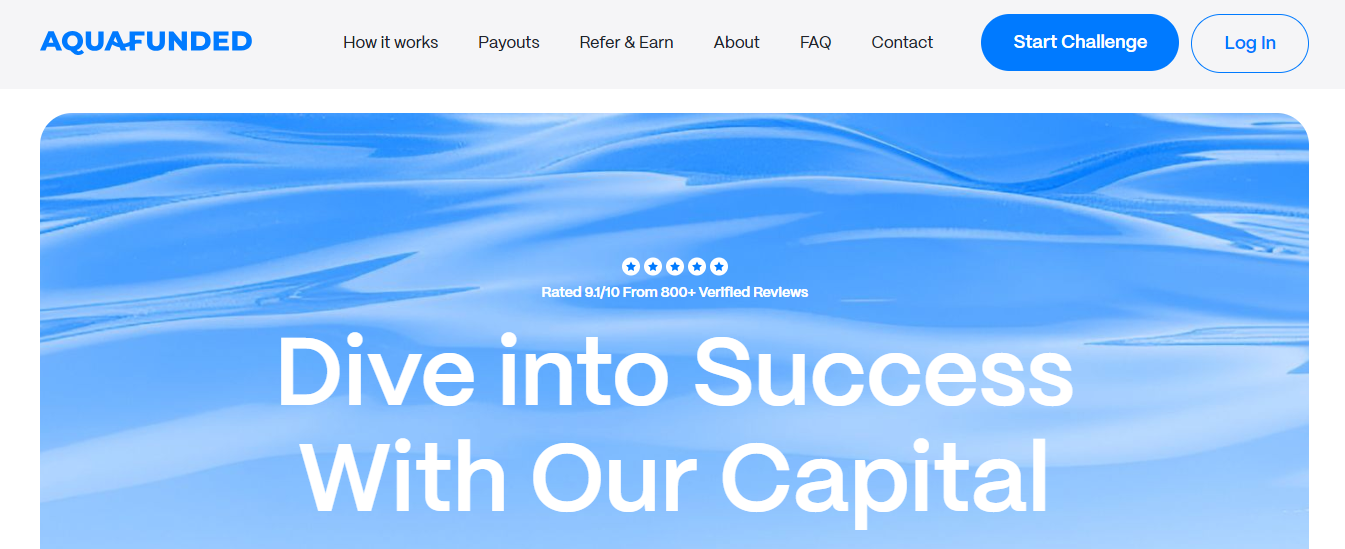Margin vs Leverage: What's the Difference
Learn the key differences between margin vs leverage and how each impacts your trading strategy in simple terms.

Balancing margin and leverage is crucial for traders in the world of Smart Money Trading. It can feel like tiptoeing through a minefield. A slip can cost you, even as the potential for gains calls from the other side. However, with the proper understanding, you can effectively utilize these tools to maximize your trading potential and make your capital work harder. That’s where this guide comes in. We’ll unpack margin and leverage, break down their differences, and show you how to use them to your advantage.
If you’re looking to supercharge your trading, consider Aqua Funded’s funded trading program. It’s designed to equip you with the skills and resources to maximize your capital, guiding you from cautious beginner to confident trader.
Importance of Margin

Maximizing Potential: Leverage Your Assets
When you buy securities on margin, you leverage the value of assets you already hold to amplify your investment. This means if your investment value climbs, your returns are magnified. Under Federal Reserve Regulation T, you can borrow up to 50% of a securities purchase. For instance, you could invest $5,000 of your funds and use a margin loan to acquire an additional $5,000 in shares, for a total investment of $10,000. This approach can be a powerful tool in your trading strategy if used judiciously.
Betting Against the Market: Profiting from Declines
Short selling enables you to benefit from a stock’s price drop. To do this, you must borrow shares through a margin account. You sell these borrowed shares, anticipating the price will fall, then repurchase them at a lower price to make a profit. Say you believe ABC Company’s stock will fall due to stiff competition. You borrow 100 shares at $50 each and sell them for $5,000. Six months later, the price dropped to $40 per share. You repurchase and return the shares, keeping the $1,000 difference. This tactic allows you to capitalize on declining markets.
Broadening Horizons: Diversifying Without Selling
A margin account can help you diversify a concentrated portfolio without liquidating assets. If a single stock, like that of your employer, dominates your portfolio, you can use those shares as collateral for a margin loan. You then use the loan to invest in other opportunities, spreading risk without triggering capital gains taxes. This flexibility lets you maintain your holdings while exploring broader market options.
Financial Flexibility: Accessing a Convenient Credit Line
Once you have a margin agreement in place, accessing a margin loan is straightforward. You can tap into this line of credit at any time, without requiring additional paperwork. This can be particularly helpful in emergencies, such as unexpected expenses or a loss of income. If your brokerage offers checking, you can even write a check against your margin account, providing a quick financial solution when needed.
Cost Efficiency: Benefiting from Low Interest Rates
While borrowing on margin incurs interest, these rates can be competitive. Pegged to the federal funds rate, margin interest might be lower than credit card or personal loan rates, especially for larger amounts. They can also rival home equity loan rates, but without the hassle of extensive paperwork. This makes margin loans an appealing option for cost-conscious investors.
Payment Freedom: Repaying on Your Schedule
With a margin loan, repayment flexibility is a key advantage. As long as you meet maintenance requirements, you can repay the loan on your timeline. This flexibility allows you to manage your debt without added pressure, making margin loans a practical choice for those seeking financial agility.
Tax Perks: Offsetting Income
Interest incurred on a margin account can sometimes offset taxable income. This potential tax benefit is worth exploring with a financial advisor. While not a primary reason to use a margin, it can be a helpful side benefit for those looking to manage their tax liabilities more effectively.
Advanced Moves: Engaging in Complex Options Strategies
By adding margin and gaining approval for options trading, you can engage in sophisticated strategies, such as spreads and butterflies. These tactics can enhance your trading repertoire, enabling you to manage risk more effectively and increase returns. Margin accounts open doors to a broader array of investment opportunities.
Stock Options: Funding Employee Plans
If you have stock options from your employer, a margin account can help you exercise them. By using securities in your account as collateral, you can borrow funds to purchase shares without selling assets or depleting cash reserves. This strategy enables you to participate in employee stock option plans without incurring immediate tax consequences.
Risk Awareness: Understanding Potential Hazards
While margin loans offer numerous benefits, they also carry risks. Leverage can amplify losses as well as gains, and margin calls can force you to sell assets at inopportune times. Interest costs and reduced flexibility are other considerations. Understanding these risks is vital to using margin responsibly and effectively.
Related Reading
- How Much Money Do You Need to Start Trading
- How Long Does It Take to Learn Trading
- What Challenges Do Traders Face?
- Futures vs Stocks Trading
- Why is Trading So Hard
- How to Swing Trade
- How to Multiply Your Money
- How to Start Trading With No Money
Importance of Leverage

The Power of Leverage in Trading
Leverage can make your trades more rewarding by increasing your purchasing power. With leverage, you can control larger positions with a smaller amount of capital, allowing you to access more expensive investment options. This can be particularly useful for traders seeking to capitalize on short-term market opportunities.
Strategic Use of Leverage
Leverage is best used in short-term situations where high levels of capital are needed. For example, a growth company may need capital for acquisitions or buyouts, creating a strong mid-to-long-term growth opportunity. By using leverage strategically, you can maximize your returns and exit your leveraged position quickly.
The Risks of Leverage
While leverage can amplify your profits, it can also increase your losses. If your investment doesn't perform as expected, you can lose more than your initial capital. Brokers and contract traders also charge fees and require you to maintain a margin account, adding to your costs.
Complexity and Risks of Leverage
Using leverage can be complex, requiring you to be aware of your financial position and the risks involved. You may need to monitor your portfolio closely and contribute additional capital to meet your broker's requirements.
Margin vs Leverage: What's the Difference

Understanding Margin and Leverage: A Crucial Distinction
Margin and leverage are two key concepts in trading that are often confused. Margin is the portion of your funds you need to deposit to open a position. Leverage lets you borrow money to increase your market exposure beyond your capital.
Margin: Your Capital's First Line of Defense
Margin acts like a security deposit, ensuring you have a stake in the game. When you trade on margin, you must maintain a minimum balance, known as the initial margin. Brokers use this to partially fund your trade. The margin is typically a percentage of the total trade size.
For instance, buying $10,000 worth of shares with a 10% margin requires just $1,000 of your own money. There are two main types of margin: initial margin, needed to open a position, and maintenance margin, the minimum you must keep to hold it.
Leverage: Amplify Gains and Losses
Leverage is the tool that allows you to control a larger position with a smaller amount of money. It's expressed as a ratio, like 10:1, 50:1, or 100:1. A 10:1 leverage means you can trade $10,000 with only $1,000 of your capital. While leverage can amplify profits, it can also magnify losses, making it a double-edged sword.
Connecting the Dots: Margin and Leverage
There's a direct mathematical link between margin and leverage. Leverage equals one divided by the margin requirement. So, a 5% margin requirement translates to 20:1 leverage, while a 2% margin equals 50:1 leverage. Lower margin requirements allow for higher leverage and vice versa.
Real-World Application: Margin and Leverage in Action
Margin trading lets you enter positions larger than your cash balance, while leverage focuses on boosting returns and risks through margin. For example, with $1,000 and a 10:1 leverage, you can take a $10,000 position. If the asset rises by 5%, your gain is $500, a 50% return on your initial capital. But if the asset falls by 5%, you face a 50% loss, highlighting how leverage increases risk.
Turn your trading skills into substantial profits without risking your capital. AquaFunded offers a funded trading program that provides access to accounts of up to $ 400,000 with flexible conditions, no time limits, easy-to-achieve profit targets, and a profit split of up to 100%. Join over 42,000 traders worldwide who've already collected more than $2.9 million in rewards, all backed by our 48-hour payment guarantee. Start trading today with instant funding options or prove your skills through our customizable challenge paths and keep up to 100% of what you earn.
10 Leverage Trading Strategies

1. Unlocking Potential: AquaFunded
AquaFunded enables you to leverage trading expertise into substantial profits without risking your funds. Traders gain access to accounts reaching $ 400,000 with flexible conditions, including no time constraints, achievable profit targets, and profit splits of up to 100%. Over 42,000 traders have received more than $2.9 million, supported by a 48-hour payout guarantee. Start trading right away with instant funding or showcase your skills through challenge paths. Keep up to 100% of your earnings.
2. Short-Selling: Breaking Support Levels
Short-selling support levels align with AquaFunded strategies. Breaking support lines often shifts market sentiment, creating momentum. Traders trusting these lines may panic when they break, triggering stop-loss orders that can lead to further market declines. It may take a few attempts to find the proper entry, but with patience and the correct stop-loss, you could profit well. Identify a dependable support level and wait; if it doesn't break, another opportunity will arise.
3. Mastery Through Focus: Learn One Market at a Time
When I started over a decade ago, I was stuck hopping from market to market, seeking opportunities and, unfortunately, profits. This approach wasn’t successful, and it likely won’t be for you either. Consistency is crucial. Stick to a single forex pair and understand its behavior. With this knowledge, you’ll identify the best setups and increase your success probability by only entering the market when you know the reasons behind your actions.
4. Risking Wisely: The 1% Rule
The 1% rule is essential. This principle dictates that you shouldn’t lose more than 1% of your total risk capital on any trade. For example, with a $1000 account, you should only risk $10 per trade. This method ensures that you can withstand multiple losses without depleting your capital. With leverage, you can increase your position size while maintaining the 1% risk. Keeping losses controlled allows you to recover with a big win.
5. Protecting Capital: Use Smart Stop-Losses
A smart stop-loss takes market volatility into account. You shouldn’t use arbitrary numbers like 50 pips; instead, use indicators like Average True Range to set stop-losses according to daily fluctuations. This approach minimizes losses and maximizes potential, particularly with smaller accounts. Adjust your stop-loss based on market conditions to avoid getting caught in volatility or using a stop that’s too wide.
6. Catching Waves: Breakouts Pay the Bills
Breakouts are among the most profitable setups in leveraged trading. They offer skewed risk-reward ratios, sometimes as high as 1 to 200. When you spot a true breakout, you can enter heavily, knowing it won’t revert to your stop-loss. Recognize a genuine breakout by noting how the market behaves before volatility shrinks and trading activity diminishes. This calm before the storm signals a real opportunity.
7. Staying Focused: Avoid News and Stick to Your Setups
News doesn’t provide new information; it’s already reflected in the market. Instead of reacting to headlines, focus on your setups. They give you an edge because you’ve studied and analyzed them. By following your setups, you’ll be the first to act in a live scenario, ready to enter when the market aligns with your strategy.
8. Increasing Leverage: On Winning Trades
Leverage is a tool to amplify winnings if used wisely. Many novice traders use the same leverage for all trades, which is a mistake. Adjust your leverage based on your entry and setup. Push the leverage meter when you’re in a profitable situation. Grade your setups from 1 to 10, and increase leverage on trades rated eight or higher. This will lead to windfall profits, just like professional traders.
9. Embrace the 80/20 Rule
The 80/20 rule explains that 80% of your profits come from 20% of your trades. This principle relies on pushing your top performers to their maximum potential. When you find a setup rated 8, 9, or 10, hit the market hard. These huge wins will make more money than your previous 10 winners combined. This is how professional traders operate.
10. Documenting Success: Write Down Your Setups
Document your setups on paper or digitally. This helps internalize them, making it easier to recognize them in live scenarios. By having a notebook of solid setups, you’ll be more effective in identifying them. Regularly review your notes and make adjustments to keep things fresh.
Related Reading
- What Happens if You Blow a Funded Account
- How to Become a Professional Trader
- Best Market to Trade for Beginners
- Tips for Day Trading
- Common Trading Mistakes
- Margin vs Leverage
- How Much Can You Make Day Trading With 100k
- Scalping Trading Strategy
- Day Trading vs Options
- Best Time Frame for Day Trading
Join Our Funded Trading Program Today - Trade with our Capital and Keep up to 100% of the Profit.

Finding a way to boost your trading skills without risking your own money sounds like a dream, right? AquaFunded offers a real opportunity. Imagine accessing accounts of up to $ 400,000, with flexible trading conditions. There are no time limits here; just achievable profit targets, and you can enjoy a profit split of up to 100%. This isn't just talk. Over 42,000 traders worldwide have already collected more than $2.9 million in rewards. Plus, there's a 48-hour payment guarantee, so you won’t be left waiting. Whether you want instant funding or prefer to prove your skills through customizable challenge paths, AquaFunded has you covered.
Margin vs. Leverage: What’s the Real Difference?
Understanding margin and leverage is crucial for smart trading. Let’s break it down. Margin is the amount of money you need to open a trade. It’s a deposit, not a cost. On the other hand, leverage lets you control a larger position with a smaller amount of capital. For instance, with 10:1 leverage, you can trade $10,000 worth of assets with just $1,000 of your own money. But be cautious. While leverage magnifies profits, it also amplifies losses. Knowing these differences can help you make informed decisions and manage your risk effectively.
Join our community of traders today and start earning with confidence.
Related Reading
- Why Do Most Day Traders Fail
- Is Day Trading Profitable
- How to Take Profits in Trading
- Fair Value Gap Trading
- Best Time of Day to Trade Stocks
- How to Make Money Online Trading
- Prop Firms With No Time Limit
- Different Stock Trading Strategies
- Swing Trading Prop Firms
- Best Technical Indicators for Day Trading


